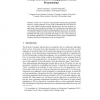Free Online Productivity Tools
i2Speak
i2Symbol
i2OCR
iTex2Img
iWeb2Print
iWeb2Shot
i2Type
iPdf2Split
iPdf2Merge
i2Bopomofo
i2Arabic
i2Style
i2Image
i2PDF
iLatex2Rtf
Sci2ools
AE
2003
Springer
2003
Springer
A Study of Diversity in Multipopulation Genetic Programming
In this work we study how using multiple communicating populations instead of a single panmictic one may help in maintaining diversity during GP runs. After defining suitable genotypic and phenotypic diversity measures, we apply them to three standard test problems. The experimental results indicate that using multiple populations helps in maintaining phenotypic diversity. We hypothesize that this could be one of the reasons for the better performance observed for distributed GP with respect to panmictic GP. Finally, we trace a sort of history of the optimum individual for a set of distributed GP runs, trying to understand the dynamics that help in maintaining diversity in distributed GP.
AE 2003 | Artificial Intelligence | GP Runs | Phenotypic Diversity | Phenotypic Diversity Measures |
| Added | 06 Jul 2010 |
| Updated | 06 Jul 2010 |
| Type | Conference |
| Year | 2003 |
| Where | AE |
| Authors | Marco Tomassini, Leonardo Vanneschi, Francisco Fernández, Germán Galeano Gil |
Comments (0)

